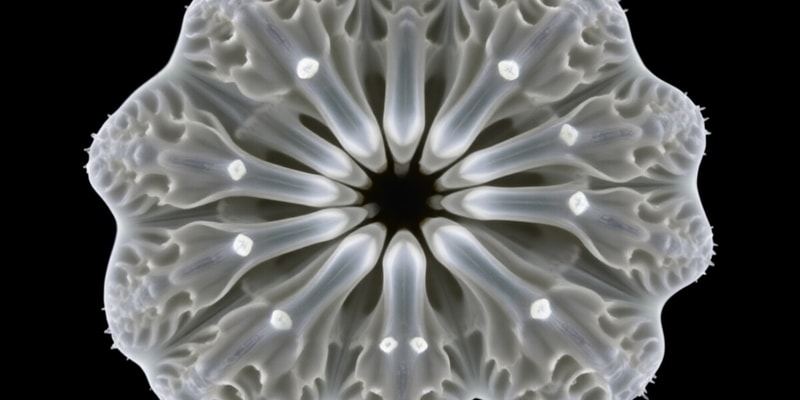Podcast
Questions and Answers
Which type of radial head fracture involves minimal displacement?
Which type of radial head fracture involves minimal displacement?
What is the most common treatment for a nondisplaced olecranon fracture?
What is the most common treatment for a nondisplaced olecranon fracture?
In which classification does a radial head fracture occur alongside an elbow dislocation?
In which classification does a radial head fracture occur alongside an elbow dislocation?
Which imaging method is typically used to assess comminuted radial head fractures?
Which imaging method is typically used to assess comminuted radial head fractures?
Signup and view all the answers
What is a common clinical feature of both radial head and olecranon fractures?
What is a common clinical feature of both radial head and olecranon fractures?
Signup and view all the answers
Which fracture type requires surgical fixation if there is greater than 2-mm displacement or 30% involvement of the radial head?
Which fracture type requires surgical fixation if there is greater than 2-mm displacement or 30% involvement of the radial head?
Signup and view all the answers
What population is most at risk for olecranon fractures?
What population is most at risk for olecranon fractures?
Signup and view all the answers
Which of the following is NOT a feature of a Type III radial head fracture?
Which of the following is NOT a feature of a Type III radial head fracture?
Signup and view all the answers
What is the main provocative test for diagnosing de Quervain's tenosynovitis?
What is the main provocative test for diagnosing de Quervain's tenosynovitis?
Signup and view all the answers
Which of the following is not considered a treatment option for de Quervain's tenosynovitis?
Which of the following is not considered a treatment option for de Quervain's tenosynovitis?
Signup and view all the answers
What is a primary characteristic feature of Intersection syndrome?
What is a primary characteristic feature of Intersection syndrome?
Signup and view all the answers
Which activity is most likely associated with the onset of Intersection syndrome?
Which activity is most likely associated with the onset of Intersection syndrome?
Signup and view all the answers
How is the diagnosis of Intersection syndrome typically confirmed?
How is the diagnosis of Intersection syndrome typically confirmed?
Signup and view all the answers
Which of the following treatments is an initial non-surgical solution for Intersection syndrome?
Which of the following treatments is an initial non-surgical solution for Intersection syndrome?
Signup and view all the answers
What common symptom might indicate de Quervain's tenosynovitis?
What common symptom might indicate de Quervain's tenosynovitis?
Signup and view all the answers
What is the typical composition of a ganglion cyst?
What is the typical composition of a ganglion cyst?
Signup and view all the answers
What is the primary stabilizer of the distal radioulnar joint?
What is the primary stabilizer of the distal radioulnar joint?
Signup and view all the answers
What is a common mechanism of injury leading to TFCC tears?
What is a common mechanism of injury leading to TFCC tears?
Signup and view all the answers
In younger athletes, what is the typical cause of TFCC tears?
In younger athletes, what is the typical cause of TFCC tears?
Signup and view all the answers
What imaging technique is essential for evaluating ulnar variance in the context of TFCC injury?
What imaging technique is essential for evaluating ulnar variance in the context of TFCC injury?
Signup and view all the answers
What is the most effective treatment for an acutely injured central articular disc of the TFCC?
What is the most effective treatment for an acutely injured central articular disc of the TFCC?
Signup and view all the answers
What is the typical mechanism of injury for a jersey finger?
What is the typical mechanism of injury for a jersey finger?
Signup and view all the answers
Which of the following clinical features is associated with a mallet finger?
Which of the following clinical features is associated with a mallet finger?
Signup and view all the answers
In the context of flexor digitorum injuries, what is true regarding imaging findings?
In the context of flexor digitorum injuries, what is true regarding imaging findings?
Signup and view all the answers
What is the primary characteristic of a Colles’ fracture?
What is the primary characteristic of a Colles’ fracture?
Signup and view all the answers
Which condition is characterized by painless nodules in the distal palmar crease?
Which condition is characterized by painless nodules in the distal palmar crease?
Signup and view all the answers
What mechanism of injury (MOI) is commonly associated with a Colles’ fracture?
What mechanism of injury (MOI) is commonly associated with a Colles’ fracture?
Signup and view all the answers
What distinguishes a Monteggia fracture from a Galleazi fracture?
What distinguishes a Monteggia fracture from a Galleazi fracture?
Signup and view all the answers
Which imaging technique is utilized for diagnosing fractures at the wrist?
Which imaging technique is utilized for diagnosing fractures at the wrist?
Signup and view all the answers
What deformity is associated with a Colles' fracture?
What deformity is associated with a Colles' fracture?
Signup and view all the answers
Which statement accurately describes a Smith's fracture?
Which statement accurately describes a Smith's fracture?
Signup and view all the answers
In Dupuytren's contracture, which finger is most commonly affected?
In Dupuytren's contracture, which finger is most commonly affected?
Signup and view all the answers
What is a common imaging finding in a case of mallet finger?
What is a common imaging finding in a case of mallet finger?
Signup and view all the answers
What is the treatment protocol for mallet finger after 6 weeks of splinting?
What is the treatment protocol for mallet finger after 6 weeks of splinting?
Signup and view all the answers
Which characteristic is NOT associated with boutonniere deformity?
Which characteristic is NOT associated with boutonniere deformity?
Signup and view all the answers
Which of the following is a complication of a Bennet’s fracture?
Which of the following is a complication of a Bennet’s fracture?
Signup and view all the answers
What distinguishes a Bennet's fracture from a Rolando's fracture?
What distinguishes a Bennet's fracture from a Rolando's fracture?
Signup and view all the answers
What initial treatment is recommended for a displaced thumb fracture?
What initial treatment is recommended for a displaced thumb fracture?
Signup and view all the answers
What clinical feature indicates a mallet finger injury?
What clinical feature indicates a mallet finger injury?
Signup and view all the answers
What indicates a severe lesion requiring surgical repair in mallet finger?
What indicates a severe lesion requiring surgical repair in mallet finger?
Signup and view all the answers
Study Notes
Radial Head Fracture
- Radial head fractures often occur alongside elbow dislocation.
- Mason Classification:
- Type I: Nondisplaced fracture
- Type II: Marginal fracture with minimal displacement
- Type III: Comminuted fracture
- Type IV: Fracture with elbow dislocation
- Common mechanism: Fall on outstretched arm.
- Symptoms include pain, swelling, and decreased range of motion.
- Treatment:
- Type I: Conservative management; immobilization for 3-5 days followed by early range of motion exercises.
- Type II: Surgical fixation if displacement exceeds 2 mm or 30% radial head involvement.
- Type III: Surgical fixation required.
- Imaging modalities:
- Plain X-rays for initial assessment.
- CT scan for comminuted fractures.
- MRI if ligamentous injury is suspected.
Olecranon Fracture
- Caused by direct trauma to a flexed elbow or a fall on an outstretched arm.
- Typically affects older adults (mean age ~57 years); bimodal distribution of injury types.
- Classification (Mayo):
- Nondisplaced
- Displaced
- Symptoms include swelling, ecchymosis, and deformity, with potential ulnar nerve involvement.
- Imaging: X-ray in A/P, lateral, and oblique views.
- Treatment:
- Nondisplaced: Conservative management with cast and early range of motion.
- Displaced: Surgical intervention (Open Reduction Internal Fixation - ORIF).
Intersection Syndrome
- Characterized by irritation of tendon compartments in the wrist, common among athletes.
- Symptoms include pain at the intersection of first and second dorsal compartments, exacerbated by wrist motion.
- Diagnosis is confirmed via clinical examination.
- Initial treatment is non-surgical: NSAIDs, activity modification, and wrist splinting.
- Surgical intervention may be needed if non-surgical management fails.
Ganglion Cyst
- Synovial fluid-filled cysts arising from the synovial sheath of joints.
Fracture of the Distal Radius
- Colles' Fracture: Most prevalent; characterized by dorsal displacement and angulation.
- Smith's Fracture: Volar displacement and angulation; considered the reverse of Colles' fracture.
- Associated with tears of the triangular fibrocartilage complex (TFCC) and scapholunate dissociation.
- Symptoms include acute pain and swelling after a fall on an outstretched arm.
- Imaging includes A/P and lateral plain films of the wrist.
- Treatment varies based on fracture details, often requiring orthopedic referral for closed reduction.
Monteggia vs. Galeazzi Fracture
- Monteggia: Fracture of the ulna with dislocation of the radial head.
- Galeazzi: Fracture of the radius with dislocation of the distal radioulnar joint.
Dupuytren's Contracture
- Thickening and contraction of the palmar fascia, often genetic (common in Northern European descent).
- Symptoms include painless nodules in the palmar crease, which may become tender.
- Involved fingers are drawn into flexion, commonly affecting the ring finger.
Triangular Fibrocartilage Complex (TFCC)
- Risk factor: Positive ulnar variance.
- Symptoms: Wrist catching/locking, tenderness in the area beneath the ulnar styloid.
- Acute injury management often involves surgical debridement; peripheral tears have slower recovery.
Jersey Finger
- Injury to the flexor tendon often seen in athletes.
- Symptoms: Inability to flex the DIP joint actively.
- Treatment typically involves early surgical repair.
Mallet Finger
- Also known as baseball finger; results from sudden passive flexion of the DIP joint.
- Symptoms: Flexed DIP joint that cannot be actively extended.
- X-rays may reveal an avulsed fragment of the distal phalanx.
- Treatment: Conservative splinting of the DIP in extension for 6-8 weeks, with possible surgical intervention.
Bennet's and Rolando's Fracture
- Bennet's fracture: Oblique fracture-subluxation at the base of the thumb metacarpal.
- Rolando's fracture: Fracture at the thumb metacarpal base that can be classified into T, Y, or comminuted types.
- Imaging: Requires AP lateral and oblique films.
- Treatment: Conservative for nondisplaced; displaced cases need orthopedic intervention.
Studying That Suits You
Use AI to generate personalized quizzes and flashcards to suit your learning preferences.
Description
This quiz covers the Mason classification of radial head fractures associated with elbow dislocations. It includes details on different types of fractures along with their clinical features and treatment options. Test your knowledge on this important topic in orthopedic practice.




